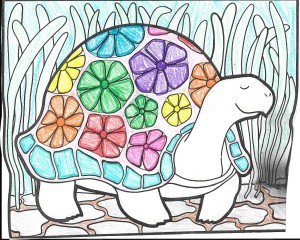Nothing quite puts a damper on outdoor fun like a sting from a bee, yellow jacket, hornet, or wasp.

Art by Corinne
While most stings, though annoying and painful, aren’t dangerous, sometimes they can be severe in certain cases.
First things first – how to avoid getting stung:
- Check the spots where your child plays for nests of stinging insects. Nests can be in trees or bushes, on structures like houses and barns, under picnic tables or by the porch. If you see an unusual number of the same type of stinging insects in one area, it’s possible there is a nest nearby. Once you’ve located a nest, you should consider calling an exterminator. If it is a honey bee hive, locate a beekeeper who will almost certainly be interested in collecting a new hive, and who knows how to do that safely. On rare occasions you might see a honey bee swarm. This occurs when a hive has gotten too large and is in the process of dividing. Be very careful to avoid the swarm and call a beekeeper immediately.
- Wear shoes outdoors. Even sandals or flip-flops are not good protection from stinging insects hiding in the grass.
- Wear light-colored clothing, and don’t wear anything with a floral pattern. Bees can be attracted to that as if it were a real flower!
- Watch what you eat outside. Insects are attracted to sweet foods and beverages and other food items like peanut butter.
- Don’t allow your child to touch even a dead stinging insect; the stinger still contains venom.
- As difficult as it may be, don’t swat at an insect because that may make it attack.
- Read about these and other preventative measures in this article by the American Academy of Pediatrics. The article contains this additional warning: “If you have disturbed a nest and the insects swarm around you, curl up as tightly as you can to reduce exposed skin. Keep your face down and cover your head with your arms.”
So, what to do after a sting?
If the child or adult is highly allergic to stings, watch closely for signs of anaphylaxis. Another article by the AAP describes an anaphylactic reaction like this:
- “A severe life-threatening allergic reaction is called anaphylaxis.
- The main symptoms are difficulty breathing and swallowing starting within 2 hours of the sting.
- Anaphylactic reactions to bee stings occur in 4 out of 1,000 children.
- The onset of widespread hives or facial swelling alone following a bee sting is usually an isolated symptom, not the forerunner of anaphylaxis. Your child’s doctor will decide.”
In the case of anaphylaxis, administer epinephrine in the form of an EpiPen or AUVI-Q, if available, and call 911.
More common reactions to stings are redness and swelling, pain and itching.
If the stinger is in the skin (only honeybees leave their stingers behind), scrape it out with your fingernail, or if it’s completely under the skin just leave it alone and it will be shed naturally.
Here are the AAP’s recommendations for care after a sting:
- “Meat Tenderizer:
- Apply a meat tenderizer-water solution on a cotton ball for 20 minutes (EXCEPTION: near the eye). This may neutralize the venom and decrease pain and swelling.
- If not available, apply aluminum-based deodorant or a baking soda solution for 20 minutes.
- Local Cold: For persistent pain, massage with an ice cube for 10 minutes.
- Pain Medicine: Give acetaminophen (e.g., Tylenol) or ibuprofen immediately for relief of pain and burning.
- Antihistamine: If the sting becomes itchy, give a dose of Benadryl. (See Dosage chart)
- Hydrocortisone Cream: For itching or swelling, apply 1% hydrocortisone cream to the sting area 3 times per day (No prescription needed).
- Expected Course: Severe pain or burning at the site lasts 1 to 2 hours. Normal swelling from venom can increase for 24 hours following the sting. The redness can last 3 days and the swelling 7 days.
- Call Your Doctor If:
- Develops difficulty breathing or swallowing (mainly during the 2 hours after the sting) (call 911)
- Redness lasts over 3 days
- Swelling becomes huge or spreads beyond the wrist or ankle
- Sting begins to look infected
- Your child becomes worse
- And remember, contact your doctor if your child develops any of the “Call Your Doctor” symptoms.”
© MBS Writing Services, 2015, all rights reserved
